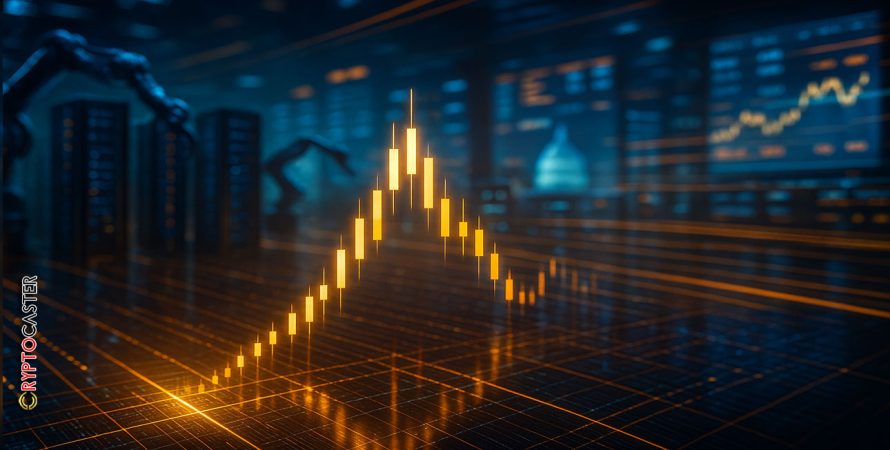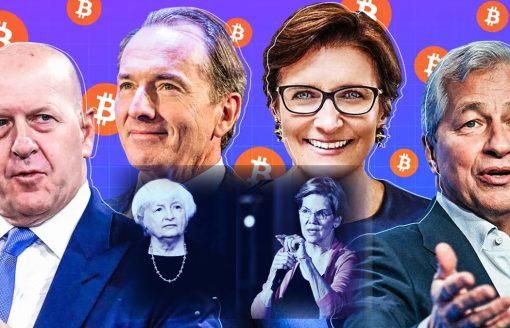By CryptoCaster Editorial Desk
$350 billion in Big Tech AI build-outs is driving stock gains and GDP headlines under Trump, but investors are starting to ask what happens when the machines stop buying.
Stay in the know on crypto by frequently visiting Crypto News Today
The U.S. economy looks unstoppable on paper. GDP growth keeps surprising to the upside, tech stocks dominate every index, and Washington is taking a victory lap. Behind the numbers, though, one force is doing almost all the heavy lifting — artificial intelligence capital spending.
CryptoCaster Quick Check:
America’s six biggest tech players — Microsoft, Google, Amazon, Apple, Meta, and Nvidia — are expected to pour more than $350 billion into AI infrastructure this year alone. That flood of investment has turned into a macro illusion: nearly 92 percent of U.S. GDP growth in early 2025 came from information-processing equipment and software. Strip that out and growth flat-lines.
AI Is the New Stimulus
For markets, this is rocket fuel. Every data-center contract and chip order triggers a mini-rally across semiconductors, construction, and power utilities. The Nasdaq 100 is up more than 25 percent YTD, led by megacaps monetizing AI demand faster than analysts can model it.
It’s the closest thing to fiscal stimulus the U.S. has right now — corporate capex as government substitute. Each server farm means new jobs, new contracts, and a fresh wave of liquidity. Wall Street loves it. So does the White House.
President Trump has framed the AI surge as proof of his “Tech Renascence” policies — lower corporate taxes, relaxed antitrust enforcement, and tariffs designed to keep supply chains domestic. But those same tariffs also raise chip and hardware costs, forcing firms to spend more just to stand still. In short: growth by compulsion.
The Concentration Trade
The entire boom hinges on a few balance sheets. Big Tech’s trillion-dollar cash hoards are offsetting weakness everywhere else — small-cap earnings, housing, and consumer credit are soft. That makes the economy look better than it feels, and stocks more crowded than ever.
Nvidia, AMD, and Broadcom keep printing record margins; builders linked to data-center projects are sold out through 2026. Meanwhile, smaller software names can’t compete for GPU supply, and their multiples keep compressing.
Markets are rewarding whoever can stay closest to the power source — literally. Grid-demand from AI facilities has become the new bottleneck, with Texas, Virginia, and Georgia already warning of overload. Energy traders now treat megawatts like call options.
When the Machines Pause
The risk is simple: if AI capex slows, the market narrative collapses. Even a mild deceleration in data-center orders could shave points off GDP and puncture the megacap premium propping up indexes. It wouldn’t take a recession — just a plateau.
Traders are watching for signs of fatigue in chip inventories, power-purchase agreements, or regulatory noise. Anything that dents momentum could force funds to rotate out of tech and back into cyclicals — a rotation nobody seems positioned for.
For crypto markets, the read-through is equally direct. The same liquidity chasing AI stocks has been cross-pollinating into AI-themed tokens and GPU-linked narratives. If the hardware cycle wobbles, so will the on-chain hype.
The Market’s Mirage
Right now, Trump’s economy looks spectacular because AI money hasn’t stopped moving. But the structure is narrow: six companies spending like sovereign states. It’s a digital version of quantitative easing — and just as fragile.
Investors betting on “AI forever” might be right for 2025. But when the servers are built and the cash turns back into depreciation expense, the real economy will have to prove it can run without a trillion-dollar power cord.
🧭 Bottom Line
AI capital spending is Wall Street’s new stimulus program — keeping the lights on for markets, politics, and GDP alike. It’s working … until it isn’t.
If this article brought you clarity, insight, or value—support the work that made it possible.
At CryptoCaster, we report on Web3, crypto markets, and institutional finance with no billionaire owners, no shareholders, and no hidden agenda. While mainstream media bends toward Elon Musk, BlackRock, and JPMorgan narratives, we stay focused on what matters: truth, transparency, and the public interest.
We don’t just cover the headlines—we investigate the power structures behind them. From FTX and Ripple to the quiet push for CBDCs, we bring fearless reporting that isn’t filtered by corporate interests.
CryptoCaster is 100% paywall-free. Always has been. To keep it that way, we depend on readers like you.
If you believe independent crypto journalism matters, please contribute—starting at just $1 in Bitcoin or Ether. Wallet addresses are below.
Your support keeps us free, bold, and accountable to no one but you.
Thank you,
Kristin Steinbeck
Editor, CryptoCaster
Support CryptoCaster: The Unfolding of Money
At CryptoCaster.world, we’re dedicated to bold journalism, sharp insights, and fearless commentary across blockchain, Web3, and crypto markets. Your **Bitcoin contributions** help us stay independent and continue delivering signal over noise.
🚨 CryptoCaster does not offer investment advice. Always DYOR—volatility is real, and risk tolerance matters.
Support our mission. Contribute BTC today.
🔗 Bitcoin Address:
3NM7AAdxxaJ7jUhZ2nyfgcheWkrquvCzRm
Thank you for backing our journalistic lens as we chronicle the Unfolding of Money — a saga still being written in real time.![]()
CRYPTOCASTER HEATMAP








